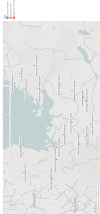Surgical referrals in Northern Tanzania: a prospective assessment of rates, preventability, reasons and patterns
- PMID: 32771008
- PMCID: PMC7414731
- DOI: 10.1186/s12913-020-05559-x
Surgical referrals in Northern Tanzania: a prospective assessment of rates, preventability, reasons and patterns
Abstract
Background: An effective referral system is essential for a high-quality health system that provides safe surgical care while optimizing patient outcomes and ensuring efficiency. The role of referral systems in countries with under-resourced health systems is poorly understood. The aim of this study was to examine the rates, preventability, reasons and patterns of outward referrals of surgical patients across three levels of the healthcare system in Northern Tanzania.
Methods: Referrals from surgical and obstetric wards were assessed at 20 health facilities in five rural regions prospectively over 3 months. Trained physician data collectors used data collection forms to capture referral details daily from hospital referral letters and through discussions with clinicians and nurses. Referrals were deemed preventable if the presenting condition was one that should be managed at the referring facility level per the national surgical, obstetric and anaesthesia plan but was referred.
Results: Seven hundred forty-three total outward referrals were recorded during the study period. The referral rate was highest at regional hospitals (2.9%), followed by district hospitals (1.9%) and health centers (1.5%). About 35% of all referrals were preventable, with the highest rate from regional hospitals (70%). The most common reasons for referrals were staff-related (76%), followed by equipment (55%) and drugs or supplies (21%). Patient preference accounted for 1% of referrals. Three quarters of referrals (77%) were to the zonal hospital, followed by the regional hospitals (17%) and district hospitals (12%). The most common reason for referral to zonal (84%) and regional level (66%) hospitals was need for specialist care while the most common reason for referral to district level hospitals was non-functional imaging diagnostic equipment (28%).
Conclusions: Improving the referral system in Tanzania, in order to improve quality and efficiency of patient care, will require significant investments in human resources and equipment to meet the recommended standards at each level of care. Specifically, improving access to specialists at regional referral and district hospitals is likely to reduce the number of preventable referrals to higher level hospitals, thereby reducing overcrowding at higher-level hospitals and improving the efficiency of the health system.
Keywords: Health systems; Reasons for referral; Referral patterns; Referral rate; Referral systems; Surgical systems.
Conflict of interest statement
David Barash is employed by GE Foundation which funded this study. The other authors have no competing interests to declare.
Figures




Similar articles
-
Understanding barriers to implementing referral procedures in the rural and semi-urban district hospitals in Tanzania: Experiences of healthcare providers working in maternity units.PLoS One. 2021 Aug 26;16(8):e0255475. doi: 10.1371/journal.pone.0255475. eCollection 2021. PLoS One. 2021. PMID: 34437576 Free PMC article.
-
Surgical ambulance referrals in sub-Saharan Africa - financial costs and coping strategies at district hospitals in Tanzania, Malawi and Zambia.BMC Health Serv Res. 2021 Jul 23;21(1):728. doi: 10.1186/s12913-021-06709-5. BMC Health Serv Res. 2021. PMID: 34301242 Free PMC article.
-
Patterns, quality and appropriateness of surgical referrals in Malawi.Trop Med Int Health. 2020 Jul;25(7):824-833. doi: 10.1111/tmi.13406. Epub 2020 May 14. Trop Med Int Health. 2020. PMID: 32324928
-
Surgical referral systems in low- and middle-income countries: A review of the evidence.PLoS One. 2019 Sep 27;14(9):e0223328. doi: 10.1371/journal.pone.0223328. eCollection 2019. PLoS One. 2019. PMID: 31560716 Free PMC article. Review.
-
Towards equitable surgical systems: development and outcomes of a national surgical, obstetric and anaesthesia plan in Tanzania.BMJ Glob Health. 2019 Apr 16;4(2):e001282. doi: 10.1136/bmjgh-2018-001282. eCollection 2019. BMJ Glob Health. 2019. PMID: 31139445 Free PMC article. Review.
Cited by
-
Using Network and Complexity Theories to Understand the Functionality of Referral Systems for Surgical Patients in Resource-Limited Settings, the Case of Malawi.Int J Health Policy Manag. 2022 Dec 6;11(11):2502-2513. doi: 10.34172/ijhpm.2021.175. Epub 2021 Dec 22. Int J Health Policy Manag. 2022. PMID: 35065544 Free PMC article.
-
Patterns of facility and patient related factors to the orthopedic and trauma admissions at the Kenyatta National Hospital: A qualitative assessment.PLOS Glob Public Health. 2024 Jan 25;4(1):e0002323. doi: 10.1371/journal.pgph.0002323. eCollection 2024. PLOS Glob Public Health. 2024. PMID: 38271345 Free PMC article.
-
The state of surgery, obstetrics, trauma, and anaesthesia care in Ghana: a narrative review.Glob Health Action. 2022 Dec 31;15(1):2104301. doi: 10.1080/16549716.2022.2104301. Glob Health Action. 2022. PMID: 35960190 Free PMC article. Review.
-
To advance global surgery and anaesthesia, train more advocates.BMJ Glob Health. 2023 Jun;8(6):e012848. doi: 10.1136/bmjgh-2023-012848. BMJ Glob Health. 2023. PMID: 37270175 Free PMC article. No abstract available.
-
Hospital readiness for the provision of care to critically ill patients in Tanzania- an in-depth cross-sectional study.BMC Health Serv Res. 2024 Feb 8;24(1):182. doi: 10.1186/s12913-024-10616-w. BMC Health Serv Res. 2024. PMID: 38331742 Free PMC article.
References
-
- WHO | Health systems. WHO. [cited 2018 Oct 22]. Available from: http://www.who.int/topics/health_systems/en/.
-
- WHO | Management of health facilities: Referral systems. WHO. [cited 2018 Oct 31]. Available from: http://www.who.int/management/facility/referral/en/.
-
- Haile T. Debas Peter Donkor Atul Gawande Dean T. Jamison Margaret E. Kruk Charles N. Mock. Disease Control Priorities, Third Edition (Volume 1): Essential Surgery. The World Bank; 2015. 442 p. (Disease Control Priorities). Available from: https://elibrary.worldbank.org/doi/abs/10.1596/978-1-4648-0346-8. - DOI - PubMed
-
- Albutt K, Yorlets RR, Punchak M, Kayima P, Namanya DB, Anderson GA, et al. You pray to your God: A qualitative analysis of challenges in the provision of safe, timely, and affordable surgical care in Uganda. PLoS ONE. 2018 17;13(4). Available from: https://www.ncbi.nlm.nih.gov/pmc/articles/PMC5903624/. - PMC - PubMed
MeSH terms
Grants and funding
LinkOut - more resources
Full Text Sources
Medical

